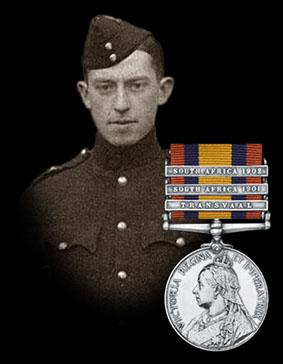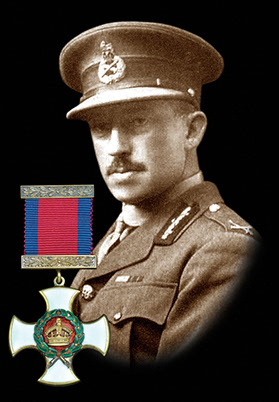Sir Edward Pius Arthur Riddell KCMG DSO**
Edward Pius Arthur Riddell, or Ted as he was known, was one of the Cambridgshire Regiment’s greatest warriors. Not hailing from Cambridgeshire and already a career regular soldier were two strikes against Riddell in a local territorial battalion but such was his compassion for the men under his command, his acumen as a soldier and his willingness to lead by example that when he finally left the battalion, to be promoted to a Brigade position, his loss was greatly lamented by all ranks. He had seen the Cambridgeshires through some of their toughest battles and commanded 1/1st Cambridgeshire on the Western Front from 10th June 1916 to 1st October 1917 with only a short interruption due to wounds.
Riddell was born on the 23rd May 1875. He was the son of John Giffard Riddell (1830-1901), of Felton Park, and Swinburne Castle, Northumberland, who served as High Sheriff of Northumberland, and his second wife Victoria (1838-1915), daughter of Peter Purcell, of Harbourstown, Co Kildare. It was one of the oldest Catholic families in the North.
Growing up in Hexham, Northumberland, Riddell was educated at Downside College, in Bath and then joined a Militia battalion of the Northumberland Fusiliers. Volunteering for service with the regulars he served as a 2nd Lieutenant during the Boer War receiving the Queen’s South Africa medal with three clasps and then transferred permanently to the Northumberland Fusiliers in February 1902. The following year he married Frances Hygnia (1877-1961), daughter of Francis John Summer, of Ealthorpe Park, Warwickshire.
In 1908 Riddell transferred to the Rifle Brigade and in January 1914 after promotion to Captain, was seconded to the Royal Military Academy Sandhurst as an instructor. Promotion to Temporary Major followed in November 1914, and Major in September 1915.
On the 10th June 1916 Riddell’s association with the Cambridgeshires started when he was attached as the Commanding Officer; succeeding Lieutenant Colonel Archer, who had returned to the UK due to ill health (further details can be found here). At first he thought the men were not up to the standards of a regular battalion but changed his opinion as he got to know them.
Riddell commanded the Battalion throughout many of its notable events: the large scale raid in July 1916, the Summer House raid, in which several senior officers were lost, the attacks on the Schwaben Redoubt, St Julien and Tower Hamlets.
The Schwaben Redoubt attack is a great opportunity to examine Riddell’s acumen as an infantry commander. The battle itself is written up elsewhere on this site (please click here for further information) but there are several keys aspects which allow us to appreciate his role. He hadn’t wanted his men out in the open, and therefore exposed, for too long prior to the attack so he deliberately disobeyed his orders and delayed the forming up. Later, one of the pivotal elements of the success of the attack was what happened immediately after the Cambridgeshires took the redoubt. Generally, standard operating procedures were to hold the captured ground, in particular to use the enemy’s trenches as a means of defence to repel any counter attacks. The problem with this was that the enemy’s artillery knew precisely the location of these trenches so it was able to bring down extremely accurate and devastating barrages to support counter attacks. Riddell’s experience paid dividends here as instructed his officers and NCOs to carry the advance beyond the positions and further into enemy territory and then to dig fresh positions or to join shell holes with trenches. This was very astute and will instantly be recognised by anyone who served in the infantry in the last 50 years as “fighting through to depth positions”. Perhaps invented by Riddell specifically for the Schwaben, it is now a standard infantry tactic and helped to both prevent casualties in the post-attack enemy bombardment and to stifle counter-attacks because the Cambridgeshires were further ahead than the enemy expected them to be and thus, crucially the redoubt was held, where other attacks had failed, and with fewer casualties than expected.
Riddell was wounded during the consolidation phase of the battle, on the 15th October. A shell struck battalion HQ leaving him with shell shock, and he was sent to England on the 18th passing on temporary command to Majors Murray, then Methuen of the Black Watch. He was also awarded the Distinguished Service Order for his actions that day.
He returned to the front in February 1917, commanding the battalion through the battles of both St Julien and Tower Hamlets. Again his skill as a leader and his acumen as a soldier were instrumental on both of those occasions and he received a bar to his DSO for St Julien. Unsurprisingly, Riddell was promoted to Temporary Brigadier of 149th (Northumberland) Brigade, taking him away from the Cambridgeshires but stayed in France and was awarded a second bar to his DSO in July 1918, probably for services during the Spring Offensive in March.
In 1919 Riddell was made a Companion of the Order of St Michael and St George and commanded the Northumbrian Brigade of 50th (Territorial) Division until his retirement in 1925. He attended various post war reunions of the Cambridgeshire Regiment and was later President of Northern area and a National Vice-President of the Royal British Legion. In 1945 he became a Knight of the Order of St Michael and St George.
He died in August 1957 at the age of 82, and was probably the Cambridgeshire Regiment’s most highly decorated officer.

A young 2nd Lt Riddell.

Brigadier "Ted" Riddell in 1918.

This site went live on the 14th February 2015 to mark 100 years since the 1/1st Cambs went off to war.
WE WILL REMEMBER THEM
Email us: cambsregt@gmail.com
Copyright 2015, 2016, 2017, 2018, 2019 by Felix Jackson. The information and images on this site should not be reproduced without prior permission.